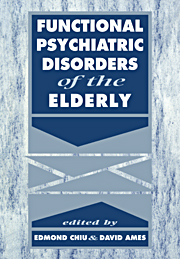Book contents
- Frontmatter
- Contents
- List of contributors
- Preface
- Introduction – A personal note
- Acknowledgement
- Part 1 Classification
- Part 2 General epidemiology
- Part 3 Neuroses
- Part 4 Affective disorders
- 7 The epidemiology of affective disorders in old age
- 8 The outcome of depressive illness in old age
- 9 Pseudodementia in geriatric depression
- 10 Depression in nursing and residential homes
- 11 Depression in primary care settings
- 12 Treatment of depression in the elderly
- 13 Mania in late life: conceptual and clinical issues
- 14 Suicide in the elderly
- Part 5 Psychosexual disorders
- Part 6 Substance use and abuse
- Part 7 Schizophrenia and related psychoses
- Part 8 Psychological, biological and medical issues
- Part 9 Treatment methods
- Part 10 Conclusion
- Index
14 - Suicide in the elderly
from Part 4 - Affective disorders
Published online by Cambridge University Press: 13 November 2009
- Frontmatter
- Contents
- List of contributors
- Preface
- Introduction – A personal note
- Acknowledgement
- Part 1 Classification
- Part 2 General epidemiology
- Part 3 Neuroses
- Part 4 Affective disorders
- 7 The epidemiology of affective disorders in old age
- 8 The outcome of depressive illness in old age
- 9 Pseudodementia in geriatric depression
- 10 Depression in nursing and residential homes
- 11 Depression in primary care settings
- 12 Treatment of depression in the elderly
- 13 Mania in late life: conceptual and clinical issues
- 14 Suicide in the elderly
- Part 5 Psychosexual disorders
- Part 6 Substance use and abuse
- Part 7 Schizophrenia and related psychoses
- Part 8 Psychological, biological and medical issues
- Part 9 Treatment methods
- Part 10 Conclusion
- Index
Summary
Introduction
Suicides are of considerable social and medical significance. The identification of patients who are likely to commit suicide is an important component of psychiatric practice, yet psychiatrists are poor at predicting suicides (Pokorny, 1983). Suicide rates among the elderly continue to be higher than in any other age group in most countries (McClure, 1987; World Health Organization (WHO), 1992). Suicide has powerful emotive qualities and causes considerable distress to relatives and professional carers (Shah, 1992a). However, suicides in older age groups have been sparsely studied (Hendon, 1982; Cattell, 1988). Furthermore, Lindesay (1991) suggests that there have been no major advances in the understanding of suicides in the elderly in recent years.
Theories of suicide are based on sociological and psychological models. Durkheim (1951) argued that suicide was an individual's response to certain social circumstances and divided suicides into three categories: egoistic, anomic and altruistic. Freud (1949) postulated a psychoanalytic formulation of suicide where a love–lationship with the lost love object incorporated into the ego leads to attack on the self. Stengel (1977) was among the first to collect systematic data to develop clinical concepts of suicide and attempted suicide. A variety of psychological factors, including presence of mental illness, have been suggested to be important in suicides. These and other related factors in the elderly may have a special and peculiar interaction with suicides.
In this chapter the literature on suicide in the elderly is reviewed with particular emphasis on methodology, cross-national rates and trends, correlates, means of suicide, overlap with attempted suicide and prevention.
- Type
- Chapter
- Information
- Functional Psychiatric Disorders of the Elderly , pp. 221 - 244Publisher: Cambridge University PressPrint publication year: 1994
- 46
- Cited by



